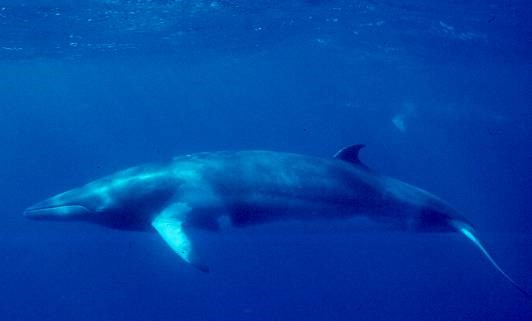
NOAA photo Identification: Minke whales may appear massive with a weight of up to 20,000 pounds (over 9,000 kg) and a length of us to 35 feet (10.6 meters), but they are the smallest of the "great whales." As a large whale with a dark body that varies from grey, black, or brown shades, and a lighter shaded belly, you may need a closer look to identify this whale. They are distinctly recognized by a band of white that runs around their pectoral (side) fins, as well as a flat mouth, and a beak-like snout. Habitat: Minke whales are found in all oceans. They may migrate with the warmer weather or remain as residents in a comfortable area. They like to roam to feed, but they can commonly be found taking advantages of bait balls. Diet: As rorquals, these mammals have throats that expand from 50-70 pleats in order to engulf as many krill and small fish as possible, later to be filtered by their baleen plates. Role in the Ecosystem: These are typically solitary whales, but can form small groupings. They are fast swimmers, with speeds of 20 mph (32 kph). While their influence in the ecosystem varies, they are sought after by researchers, although not easily studied due to their quick nature. They are hunted in some waters, but still appear to be common, perhaps thanks to their speed as well. Fun Fact: Minke whales make a unique "boing" sound that had been recorded for years, but was not able to be identified as that of a minke whale until 2002. Back to Species List |
Last updated: September 29, 2020
